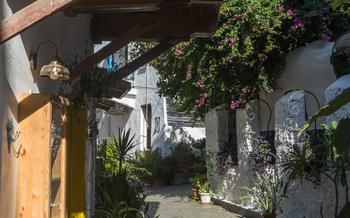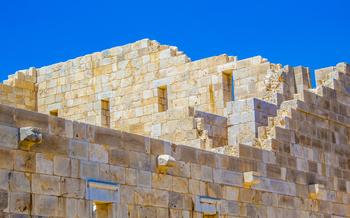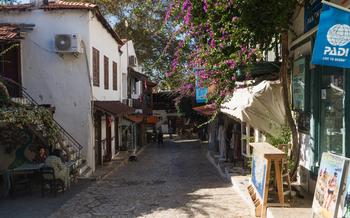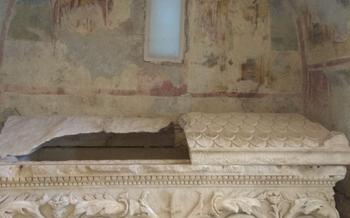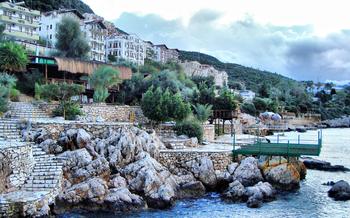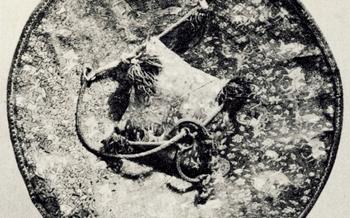
Patara Ancient City
- Historical Significance
- Architectural Marvels
- Natural Beauty
- Patara Beach: A Paradise for Sun, Sand, and Sea Turtles
- Lycian Rock Tombs: Marvels Carved into the Cliffs
- The Theater
- The Agora
- The City Walls
- The Granary: A Testament to Patara's Provisions
- The Temple of Apollo
- The Baths
- The Museum: A Window into Patara's Past
- Getting There
- Tips for Visitors
- Insider Tip: Embark on a Sunset Stroll Along Patara Beach
Historical Significance
Patara, an ancient city of great historical significance, once flourished as a prominent center of the Lycian civilization. Its strategic location on the Mediterranean coast made it a vital port and trading hub in ancient times. The city's wealth and influence attracted the attention of various civilizations, including the Lycians, Romans, and Byzantines, each of whom left their mark on Patara's rich history.
As a major Lycian city, Patara played a crucial role in the Lycian League, a powerful confederation of Lycian cities. Its strategic location and natural harbor allowed it to thrive as a center of commerce and trade, connecting the Lycians with other Mediterranean civilizations. The city's wealth and prosperity are evidenced by the impressive ruins and artifacts that have survived to this day.
During the Roman period, Patara continued to flourish as an important port city. The Romans constructed various buildings and infrastructure, including a theater, baths, and a granary, transforming Patara into a significant center of Roman administration and trade. The city also became a major center of Christianity, with the Apostle Paul visiting Patara on his missionary journeys.
In the Byzantine era, Patara remained an important city, serving as the seat of a bishop and a center of religious activity. However, the city's decline began during this period due to the rise of nearby ports and the gradual decline of the Byzantine Empire. Despite its diminished status, Patara's historical significance endures, attracting visitors from around the world who come to explore its ancient ruins and delve into its rich past.
Architectural Marvels
Patara's ruins are a testament to the skill and ingenuity of the ancient Lycians. The well-preserved theater, with its impressive seating capacity and remarkable acoustics, stands as a testament to their architectural prowess. The agora, the city's central marketplace, features well-preserved shops, colonnades, and other structures that provide a glimpse into Patara's bustling past.
The Lycian rock tombs, carved into the surrounding cliffs, are another highlight of Patara. These elaborate tombs, with their intricate facades and carvings depicting scenes from Lycian mythology, offer a unique glimpse into the funerary practices and beliefs of this ancient civilization.
Ongoing excavations and restoration efforts are continuously uncovering new insights into Patara's past. These efforts are shedding light on the city's urban planning, its economic and social structures, and its role as a major cultural and religious center in ancient Lycia.
Natural Beauty
Patara is not only renowned for its historical significance but also for its breathtaking natural beauty. The city is surrounded by picturesque landscapes, including the stunning Patara Beach, considered one of Turkey's most beautiful beaches. With its pristine sands, crystal-clear waters, and panoramic views of the Mediterranean Sea, Patara Beach is a paradise for beach lovers and nature enthusiasts alike.
The area surrounding Patara is also home to a diverse range of flora and fauna. Visitors can spot various plant species, including oleanders, bougainvillea, and olive trees, which add color and fragrance to the landscape. The region is also a haven for wildlife, including numerous bird species, reptiles, and insects. One of the most notable inhabitants of Patara Beach is the endangered loggerhead sea turtle. These majestic creatures nest on the beach, and visitors can witness the incredible sight of baby turtles hatching and making their way to the sea.
Preserving the natural beauty of Patara and its surroundings is of paramount importance. Visitors are encouraged to respect the environment and follow responsible tourism practices to ensure that future generations can continue to enjoy this natural treasure.
Patara Beach: A Paradise for Sun, Sand, and Sea Turtles
Patara Beach is the jewel in the crown of Patara Ancient City, renowned for its pristine sands, crystal-clear waters, and breathtaking natural beauty. Stretching for over 18 kilometers along the Turquoise Coast, Patara Beach is widely considered one of the most beautiful beaches in Turkey and a must-visit destination for beach lovers and nature enthusiasts alike.
Beyond its scenic beauty, Patara Beach holds immense significance as a nesting site for the endangered loggerhead sea turtles (Caretta caretta). These gentle giants migrate to Patara's shores every year to lay their eggs, making it one of the most important nesting sites in the Mediterranean. To protect these magnificent creatures, the beach has been declared a Specially Protected Area, and strict measures are in place to minimize human disturbance during the nesting season.
For beachgoers, Patara offers a range of facilities and activities to enhance their experience. Visitors can rent umbrellas and sun loungers, indulge in refreshing drinks and snacks at the beach bars, or take a leisurely stroll along the shore, enjoying the tranquility of this unspoiled paradise.
To reach Patara Beach, visitors can take a short walk from the ancient city or drive directly to the beach. Ample parking is available, making it convenient for those arriving by car. The beach is also easily accessible for visitors with disabilities, with designated ramps and accessible pathways.
Whether you're seeking relaxation, adventure, or a chance to witness the wonders of nature, Patara Beach has something to offer everyone. Immerse yourself in the beauty of this pristine beach, bask in the warm sunshine, take a refreshing dip in the turquoise waters, and create memories that will last a lifetime.
Lycian Rock Tombs: Marvels Carved into the Cliffs
The Lycian rock tombs are a testament to the artistry and engineering prowess of the ancient Lycians. Carved into the sheer cliffs surrounding Patara, these impressive tombs are a unique feature of the site. Their intricate facades, adorned with reliefs depicting scenes from Lycian mythology, offer a glimpse into the beliefs and practices of this ancient civilization. The tombs vary in size and design, from simple chambers to elaborate structures with multiple rooms and columns. The largest and most impressive tomb is known as the "Tomb of the Nereids," which features intricate carvings depicting a procession of Nereids, sea nymphs from Greek mythology. Ongoing research and efforts to preserve these ancient tombs ensure that they continue to captivate and inspire visitors to Patara.
The Theater
The theater of Patara is a magnificent and well-preserved structure that stands as a testament to the city's cultural and artistic heritage. Built in the 2nd century AD, it is one of the largest ancient theaters in Turkey, with a seating capacity of over 5,000 spectators. The theater's impressive size and elaborate architecture reflect the importance of entertainment and public gatherings in ancient Patara.
The theater is constructed from local stone and features a distinctive horseshoe-shaped auditorium. The stage is adorned with intricate carvings and sculptures, depicting scenes from Greek mythology and the history of Patara. The acoustics of the theater are remarkable, allowing performers' voices to carry clearly throughout the auditorium.
In ancient times, the theater was used for a variety of performances, including plays, concerts, and gladiator fights. Today, the theater is occasionally used for cultural events and performances, offering visitors a unique opportunity to experience the theater's ancient atmosphere and acoustics.
Restoration efforts are ongoing to preserve and maintain the theater's grandeur. Visitors can explore the theater's auditorium, stage, and backstage areas, marveling at the intricate details and imagining the lively atmosphere of ancient performances. The theater of Patara is a must-see attraction for anyone interested in ancient history, architecture, or the performing arts.
The Agora
The agora, or marketplace, of Patara was the bustling heart of the ancient city, a vibrant hub of trade and commerce. Located in the city center, the agora was a large open square surrounded by colonnades and lined with shops, stalls, and other commercial establishments.
The shops in the agora sold a wide variety of goods, including food, clothing, pottery, jewelry, and other items essential for daily life. Merchants from all over the region brought their goods to Patara to sell, making the agora a melting pot of cultures and a place where people from different backgrounds could interact and exchange ideas.
The agora was not just a place of commerce but also a social and political center. It was here that the city's leaders met to discuss important issues and make decisions, and where public announcements were made. The agora was also a place where people could gather to socialize, exchange news, and participate in religious ceremonies.
Today, the agora is still an impressive sight, with its well-preserved colonnades and the remains of shops and other structures. The agora provides a glimpse into the bustling commercial and social life of Patara and is a reminder of the city's importance as a major trading hub in ancient times.
Ongoing excavations and research in the agora are shedding light on the economic and social life of Patara. Archaeologists have uncovered evidence of a variety of commercial activities, including the production of pottery, textiles, and metal goods. The agora is also home to a number of inscriptions and other artifacts that provide valuable insights into the daily lives of Patara's inhabitants.
The City Walls
The city walls of Patara stand as a testament to the city's strategic importance and architectural prowess. Constructed using a combination of local stone and brick, these massive fortifications once encircled the entire city, providing protection from potential invaders. The walls feature impressive towers and gates, allowing for controlled access and defense.
The construction techniques employed in the city walls are a marvel of ancient engineering. The use of large stone blocks, carefully fitted together without the use of mortar, demonstrates the skill and precision of the Lycian builders. The walls' thickness and height, reaching up to 12 meters in some sections, provided a formidable barrier against enemy attacks.
The strategic location of Patara, situated on a narrow peninsula and surrounded by natural barriers, made the city difficult to access by land or sea. The city walls further enhanced this defensive position, creating a formidable obstacle for any potential attackers. The walls also served as a symbol of power and prestige, demonstrating Patara's status as a major city and trading hub in the Lycian League.
Today, the city walls of Patara stand as ruins, yet their imposing presence and architectural grandeur continue to captivate visitors. Ongoing restoration and preservation efforts are underway to protect these ancient fortifications and ensure their survival for future generations.
The Granary: A Testament to Patara's Provisions
The granary of Patara stands as a testament to the city's strategic importance in ancient times. This massive structure served as a vital storehouse, ensuring food security for the city's large population. Constructed with remarkable precision and engineering, the granary showcased Patara's architectural prowess.
The granary's design prioritized efficiency and functionality. Its vast interior was divided into multiple chambers, each capable of storing vast quantities of grain and other provisions. The chambers were carefully ventilated to prevent spoilage and maintain the quality of the stored goods.
The granary's strategic location within the city walls further emphasized its significance. In times of siege or conflict, the secure storage of food supplies was crucial for the city's survival. The granary played a pivotal role in sustaining Patara's population during challenging periods.
Today, the ruins of the granary stand as a reminder of Patara's foresight and planning. Ongoing research and excavations are shedding light on the granary's role in the city's economy and trade. This magnificent structure serves as a testament to the ingenuity and resilience of the ancient inhabitants of Patara.
The Temple of Apollo
Amidst the ruins of Patara, the Temple of Apollo stands as a testament to the city's religious and cultural significance. Dedicated to the revered Greek god of light, music, and prophecy, this sacred sanctuary once echoed with the prayers and rituals of Patara's ancient inhabitants.
The temple's imposing structure, though weathered by time, hints at its former grandeur. Its colossal columns, intricately carved with scenes from Lycian mythology, once supported a majestic roof that sheltered the sanctum within. Inside, a colossal statue of Apollo, sculpted with divine precision, gazed serenely upon his devoted followers.
The Temple of Apollo was more than just a place of worship; it was a hub of spiritual and intellectual exchange. Oracles, believed to possess the gift of prophecy, delivered cryptic messages and guidance to those who sought divine counsel. Pilgrims from distant lands flocked to Patara, drawn by the allure of Apollo's wisdom and the sanctity of his temple.
Today, the ruins of the Temple of Apollo stand as a poignant reminder of Patara's rich religious heritage. Though its walls are worn, and its once-vibrant colors have faded, the temple's aura of spirituality lingers, inviting visitors to contemplate the profound beliefs that shaped ancient Lycian society.
The Baths
The Roman baths in Patara are a testament to the city's grandeur and the importance of bathing in ancient Roman culture. Built during the Roman period, the baths were an essential part of Roman society, serving as places for relaxation, socializing, and maintaining personal hygiene.
The Patara baths are remarkably well-preserved, with various sections still intact. Visitors can explore the frigidarium, the cold room where bathers would start their bathing ritual. The tepidarium, the warm room, and the caldarium, the hot room, where they would experience different temperatures and enjoy the therapeutic benefits of steam and heat.
The baths also feature impressive architectural elements, including vaulted ceilings, intricate mosaics, and decorative niches. These details provide a glimpse into the artistic and engineering prowess of the ancient Romans.
Today, the Patara baths stand as a reminder of the city's cosmopolitan nature and its embrace of Roman customs and traditions. Visitors can wander through the ruins, imagining the bustling atmosphere and the social interactions that took place within these ancient walls.
The ongoing efforts to restore and preserve the baths ensure that future generations can appreciate this significant part of Patara's history and gain insights into the daily lives of its inhabitants.
The Museum: A Window into Patara's Past
The Patara Museum is a treasure trove of artifacts and exhibits that bring to life the rich history and culture of this ancient city. Located in the heart of Patara, the museum houses a diverse collection that spans from prehistoric times to the Byzantine era, offering visitors a glimpse into the city's vibrant past.
Among the highlights of the museum's collection are exquisite sculptures, intricate pottery, and everyday objects that provide insights into the daily lives of Patara's inhabitants. Visitors can admire finely crafted statues of gods and goddesses, marvel at the delicate details of ceramic vessels, and learn about the tools and implements used by the city's artisans and merchants.
The museum also features informative displays and panels that provide historical context and explanations for the artifacts on display. These exhibits explore Patara's role as a major port and trading hub, its interactions with neighboring civilizations, and the influence of various cultures on the city's development.
A visit to the Patara Museum is an essential part of any trip to this ancient city. It allows visitors to connect with the past and gain a deeper understanding of the people and events that shaped Patara's remarkable history.
Getting There
Reaching Patara is a breeze, with multiple transportation options available. From major cities like Antalya, hop on a scenic bus ride that takes you directly to the ancient city. If you prefer a self-paced journey, rent a car and enjoy the flexibility of exploring the region at your own pace. Driving directions are straightforward, and the roads are well-maintained.
Patara's accessibility extends to visitors with disabilities, as ramps and designated parking spaces ensure a comfortable visit for all. Once you arrive, you'll find yourself immersed in the charm of nearby towns and villages. Whether you choose to base yourself in Kalkan, Kas, or Fethiye, these vibrant hubs offer a delightful blend of history, culture, and modern amenities, making them ideal starting points for your Patara adventure.
Tips for Visitors
To make the most of your visit to Patara, consider these helpful tips:
-
Plan your visit during the shoulder seasons (May-June and September-October) to avoid the crowds and enjoy more pleasant weather.
-
Book a guided tour or hire a local guide to gain insights into Patara's history, culture, and architecture. They can lead you to hidden gems and share fascinating stories that bring the ancient city to life.
-
Bring comfortable shoes, a hat, and sunscreen, as you will be doing a lot of walking and exploring under the sun.
-
Pack a swimsuit and towel if you plan to swim or sunbathe at Patara Beach. Remember to respect the nesting areas of loggerhead sea turtles and follow the guidelines for responsible beach behavior.
-
Bring your camera to capture the stunning scenery, ancient ruins, and wildlife of Patara. The golden hour (just after sunrise or before sunset) is an excellent time to take photographs.
-
Be mindful of the historical significance of the site and follow guidelines for responsible tourism. Avoid touching or climbing on the ruins and respect the natural environment by leaving no trace.
-
Support local businesses by dining at traditional Turkish restaurants, shopping at local markets, and staying at locally-owned guesthouses or hotels.
Insider Tip: Embark on a Sunset Stroll Along Patara Beach
As the sun begins its descent, casting a golden glow over the ancient ruins and the shimmering waters of the Mediterranean Sea, embark on a magical stroll along the pristine sands of Patara Beach. This hidden gem, often overlooked by tourists, offers a tranquil and breathtaking experience. Feel the soft sand beneath your feet as you wander along the shore, marveling at the stunning views of the ancient city bathed in the warm hues of the sunset. Let the gentle sound of the waves lull you into a state of serenity, and soak in the beauty of this unspoiled paradise. Remember to bring your camera to capture the mesmerizing spectacle of the sunset over Patara, a moment that will forever be etched in your memory.
